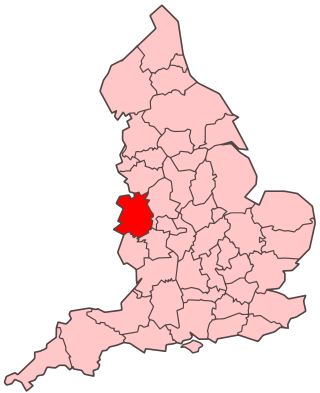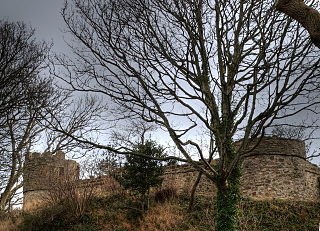Gruffydd ap Llywelyn was the first and only Welsh king to unite all of Wales under his rule from 1055 to 1063. He had also previously been King of Gwynedd and Powys from 1039 to 1055. Gruffydd was the son of Llywelyn ap Seisyll, king of Gwynedd, and Angharad daughter of Maredudd ab Owain, king of Deheubarth, and the great-great-grandson of Hywel Dda. After his death, Wales was again divided into separate kingdoms.
Magnus Haraldsson was King of Norway from 1066 to 1069, jointly with his brother Olaf Kyrre from 1067. He was not included in official Norwegian regnal lists until modern times, but has since been counted as Magnus II.

Gruffudd ap Cynan was King of Gwynedd from 1081 until his death in 1137. In the course of a long and eventful life, he became a key figure in Welsh resistance to Norman rule.

Hugh d'Avranches, nicknamed le Gros or Lupus, was from 1071 the second Norman Earl of Chester and one of the great magnates of early Norman England.

The Kingdom of Gwynedd was a Welsh kingdom and a Roman Empire successor state that emerged in sub-Roman Britain in the 5th century during the Anglo-Saxon settlement of Britain.

Magnus III Olafsson, better known as Magnus Barefoot, was the King of Norway from 1093 until his death in 1103. His reign was marked by aggressive military campaigns and conquest, particularly in the Norse-dominated parts of the British Isles, where he extended his rule to the Kingdom of the Isles and Dublin.

Hugh of Montgomery, 2nd Earl of Shrewsbury, was an Anglo-Norman aristocrat and member of the House of Bellême. He was also known as Hugh the Red.

Muirchertach Ua Briain, son of Toirdelbach Ua Briain and great-grandson of Brian Boru, was King of Munster and later self-declared High King of Ireland.

Robert of Rhuddlan was a Norman adventurer who became lord of much of north-east Wales and for a period lord of all North Wales.

Cadwgan ap Bleddyn (1051–1111) was a prince of the Kingdom of Powys in north eastern Wales. He was the second son of Bleddyn ap Cynfyn who was king of both Kingdom of Powys and Gwynedd.

The Norman invasion of Wales began shortly after the Norman conquest of England under William the Conqueror, who believed England to be his birthright. Initially (1067–1081), the invasion of Wales was not undertaken with the fervour and purpose of the invasion of England. However, a much stronger Norman invasion began in 1081 and by 1094 most of Wales was under the control of William's son and heir, the later King William II. The Welsh greatly disliked the "gratuitously cruel" Normans, and by 1101, had regained control of the greater part of their country under the long reign of King Gruffudd ap Cynan, who had been imprisoned by the Normans for twelve years before his escape.
This article is about the particular significance of the century 1001–1100 to Wales and its people.

Wales in the High Middle Ages covers the 11th to 13th centuries in Welsh history. Beginning shortly before the Norman invasion of the 1060s and ending with the Conquest of Wales by Edward I between 1278 and 1283, it was a period of significant political, cultural and social change for the country.

Wales in the Middle Ages covers the history of the country that is now called Wales, from the departure of the Romans in the early fifth century to the annexation of Wales into the Kingdom of England in the early sixteenth century. This period of about 1,000 years saw the development of regional Welsh kingdoms, Celtic conflict with the Anglo-Saxons, reducing Celtic territories, and conflict between the Welsh and the Anglo-Normans from the 11th century.

Llanfaes is a small village on the island of Anglesey, Wales, located on the shore of the eastern entrance to the Menai Strait, the tidal waterway separating Anglesey from the north Wales coast. Its natural harbour made it an important medieval port and it was briefly the capital of the kingdom of Gwynedd. Following Prince Madoc's Rebellion, Edward I removed the Welsh population from the town and rebuilt the port a mile to the south at Beaumaris. It is in the community of Beaumaris.

The history of Gwynedd in the High Middle Ages is a period in the history of Wales spanning the 11th to the 13th centuries. Gwynedd, located in the north of Wales, eventually became the most dominant of Welsh polities during this period. Contact with continental courts allowed for Gwynedd to transition from a petty kingdom into an increasingly sophisticated principality of seasoned courtiers capable of high-level diplomacy and representation, not only with the Angevin kings of England, but with the king of France and the Papacy. Distinctive achievements in Gwynedd include the further development of medieval Welsh literature, particularly the work of the princely court poets known as Beirdd y Tywysogion and the reformation of bardic schools; and the continued development of Cyfraith Hywel. All three of these further contributed to the development of a Welsh national identity in the face of Anglo-Norman encroachment on Wales.

The House of Aberffraw was a medieval royal court based in the village it was named after, Aberffraw, Anglesey within the borders of the then Kingdom of Gwynedd. The dynasty was founded in the 9th century by a King in Wales whose descendants founded the Welsh Royal Houses. The other medieval Welsh dynasties were the Royal Houses of Dinefwr, Mathrafal.

Castell Aberlleiniog is a motte and bailey fortress near the Welsh village of Llangoed on the Isle of Anglesey, built between 1080 and 1099 by Hugh d'Avranches, 1st Earl of Chester. It is about two miles distant from Beaumaris Castle, and was built atop a very steep hill.

St Tyfrydog's Church, Llandyfrydog is a small medieval church, in Llandyfrydog, Anglesey, north Wales. The date of establishment of a church on this site is unknown, but one 19th-century Anglesey historian says that it was about 450. The oldest parts of the present building are dated to about 1400, with the chancel dating from the late 15th or early 16th century. It is built from rough, small, squared stones, dressed with limestone. One of the windows on the south side is raised to illuminate the pulpit, a decision that in the eyes of one 19th-century commentator "disfigures the building."
Owain ab Edwin of Tegeingl or Owain the Traitor, was lord of the cantref of Tegeingl in north-east Wales at the end of the 11th century. He was the son of Edwin ap Gronw of Tegeingl, a great-great-grandson of Hywel Dda. He sided with the Normans in their failed invasion of North Wales, and in the 1090s attempted to become ruler of Gwynedd.














